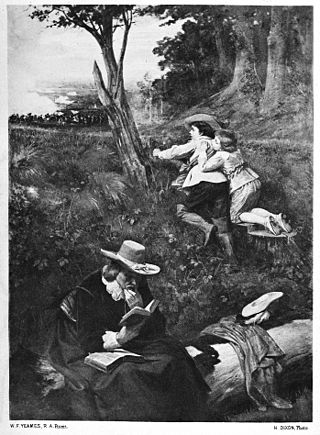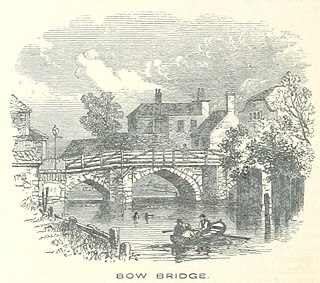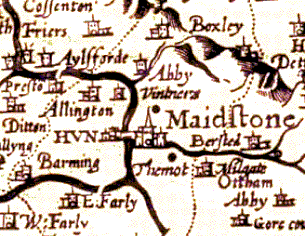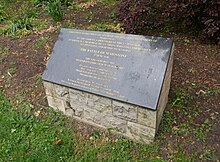
The English Civil War was a series of civil wars and political machinations between Royalists and Parliamentarians in the Kingdom of England from 1642 to 1651. Part of the wider 1639 to 1653 Wars of the Three Kingdoms, the struggle consisted of the First English Civil War and the Second English Civil War. The Anglo-Scottish War of 1650 to 1652 is sometimes referred to as the Third English Civil War.

The Battle of Edgehill was a pitched battle of the First English Civil War. It was fought near Edge Hill and Kineton in southern Warwickshire on Sunday, 23 October 1642.

Sir Charles Lucas, 1613 to 28 August 1648, was a professional soldier from Essex, who served as a Royalist cavalry leader during the Wars of the Three Kingdoms. Taken prisoner at the end of the First English Civil War in March 1646, he was released after swearing not to fight against Parliament again, an oath he broke when the Second English Civil War began in 1648. As a result, he was executed following his capture at the Siege of Colchester in August 1648, and became a Royalist martyr after the 1660 Stuart Restoration.

The Second English Civil War took place between February and August 1648 in England and Wales. It forms part of the series of conflicts known collectively as the 1639–1653 Wars of the Three Kingdoms, which include the 1641–1653 Irish Confederate Wars, the 1639–1640 Bishops' Wars, and the 1649–1653 Cromwellian conquest of Ireland.

Henry Hastings, 1st Baron Loughborough, 28 September 1610 to 10 January 1667, was the younger son of Henry Hastings, 5th Earl of Huntingdon, one of the most powerful landowners in Leicestershire. He fought with the Royalist army in the Wars of the Three Kingdoms, and narrowly escaped execution after being captured at Colchester in 1648. He spent the next twelve years with the Stuart court in exile, and became a leading member of the Sealed Knot, a body set up to co-ordinate Royalist plots against The Protectorate. Hastings returned home after the 1660 Stuart Restoration, and was appointed Lord Lieutenant of Leicestershire in 1661, a position he retained until his death in January 1667.

Sir Michael Livesey, 1st Baronet, also spelt Livesay, was a Puritan activist and Member of Parliament who served in the Parliamentarian army during the Wars of the Three Kingdoms. He was one of the regicides who approved the Execution of Charles I in January 1649.

The Battle of Langport took place on 10 July 1645 during the First English Civil War, near Langport in Somerset.

The Battle of Turnham Green took place on 13 November 1642 near the village of Turnham Green, at the end of the first campaigning season of the First English Civil War. The battle resulted in a standoff between the forces of King Charles I and the much larger Parliamentarian army under the command of the Earl of Essex. In blocking the Royalist army's way to London immediately, however, the Parliamentarians gained an important strategic victory as the standoff forced Charles and his army to retreat to Oxford for secure winter quarters.

Sir William Brockman (1595–1654) was an English landowner and military leader. He is best known for his staunch, if unsuccessful, defence of Maidstone in the Royalist cause, during the English Civil War.

The siege of Colchester occurred in the summer of 1648 when the Second English Civil War reignited in several areas of Britain. Colchester found itself in the thick of the unrest when a Royalist army on its way through East Anglia to raise support for the King, was attacked by Lord-General Thomas Fairfax at the head of a Parliamentary force. The Parliamentarians' initial attack forced the Royalist army to retreat behind the town's walls, but they were unable to bring about victory, so they settled down to a siege. Despite the horrors of the siege, the Royalists resisted for eleven weeks and only surrendered following the defeat of the Royalist army in Northern England at the Battle of Preston (1648).
The siege of Reading was an eleven-day blockade of Reading, Berkshire, during the First English Civil War. Reading had been garrisoned by the Royalists in November 1642, and held 3,300 soldiers under the command of Sir Arthur Aston. On 14 April 1643, Robert Devereux, 3rd Earl of Essex brought a Parliamentarian army of 19,000 men to lay siege to the town, and began bombarding the town two days later.

Penenden Heath is a suburb of the town of Maidstone in the English county of Kent. As the name suggests, it was developed on an area of heathland, an area of which remains as a recreation ground with some woodland.

Cornwall played a significant role in the English Civil War, being a Royalist enclave in the generally Parliamentarian south-west.
The history of Maidstone and its environs goes as far back as Mesolithic times. It has seen settlement by the Romans and the Normans and played a role in pivotal moments of English history such as the Peasants' Revolt and the English Civil War. It has also hosted an Army barracks since Napoleonic times and was an important centre for Kent's brewing and papermaking industries.

Colonel Nathaniel Rich was a member of the landed gentry from Essex, who sided with Parliament during the Wars of the Three Kingdoms. He has been described as "an example of those pious Puritan gentlemen who were inspired by the ideals of the English Revolution".

The capture of Wakefield occurred during the First English Civil War when a Parliamentarian force attacked the Royalist garrison of Wakefield, Yorkshire. The Parliamentarians were outnumbered, having around 1,500 men under the command of Sir Thomas Fairfax, compared to the 3,000 led by George Goring in Wakefield. Despite being outnumbered, Parliamentarians successfully stormed the town, taking roughly 1,400 prisoners.

Bow Bridge was a stone bridge built over the River Lea, in what is now London, in the twelfth century. It took its name from the distinctively bow-shaped (curved) arches.
The Battle of Tadcaster took place during the First English Civil War on 7 December 1642, when a Royalist force attacked the Parliamentarian garrison of Tadcaster, Yorkshire, which was held by between 900 and 1,500 soldiers under the command of Ferdinando Fairfax, Lord Fairfax. The Earl of Newcastle marched out of York on 6 December, and split his force of 6,000 into two; he took 4,000 infantry down the main York–Tadcaster road to attack the town from the east, while sending a deputy, the Earl of Newport, with a further 1,500 to circle around and trap the Parliamentarians by attacking from the north-west.

The Battle of St Neots on 10 July 1648 was a skirmish during the Second English Civil War at St Neots in Cambridgeshire. A Royalist force led by the Earl of Holland and Colonel John Dalbier was defeated by 100 veteran troops from the New Model Army, commanded by Colonel Adrian Scrope.
The Kent Trained Bands were a part-time military force recruited from Kent in South East England, organised from earlier levies in 1572. They were periodically embodied for home defence and internal security, including the Spanish Armada campaign in 1588, and saw active service during the Wars of the Three Kingdoms. They were replaced by the Militia in 1662.

















